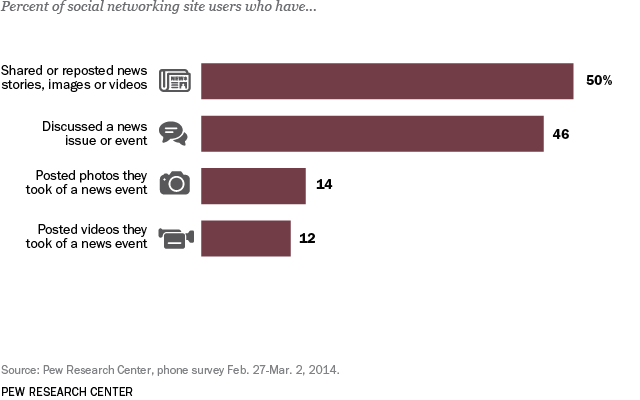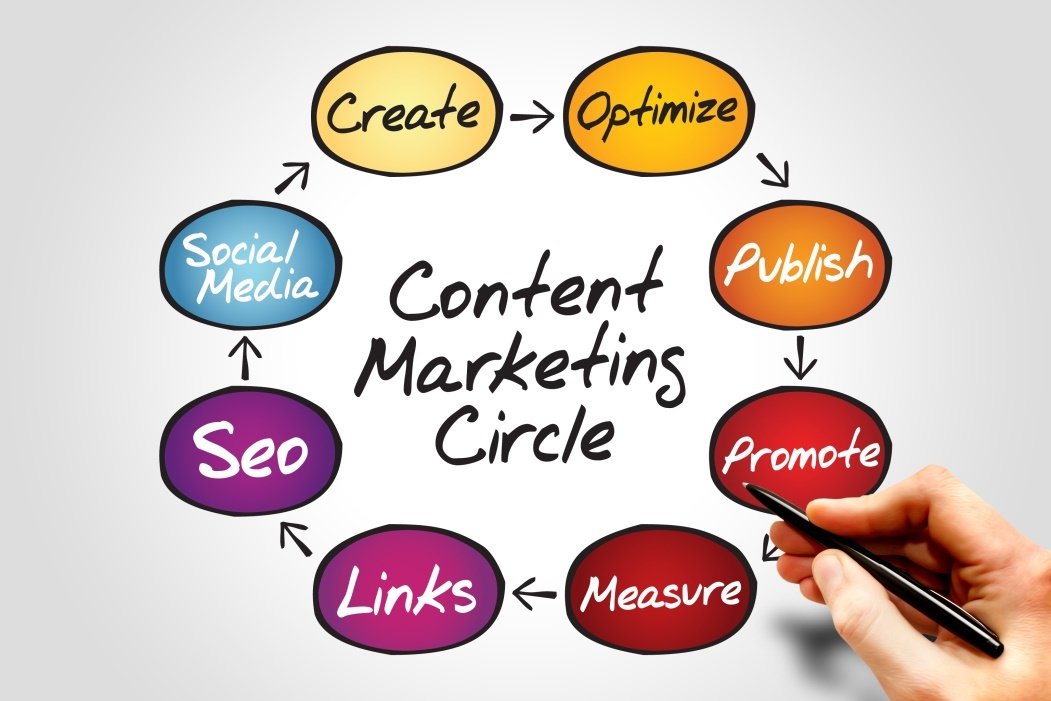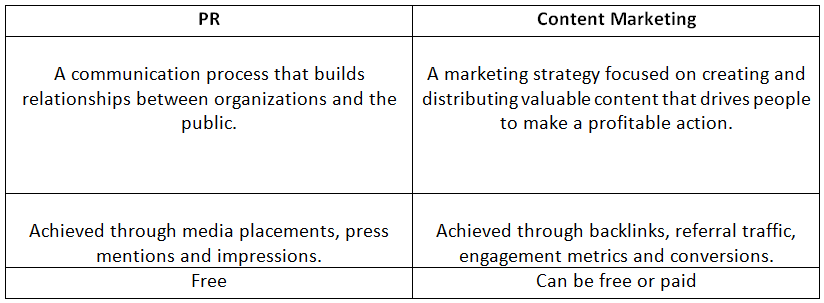
Are you ready to learn the difference between PR and Content Marketing?
If so, then this article will help you publicize your business while understanding the key differences between PR and Content Marketing.
After all, what good is a business if no one knows it exists?
Let’s dig right in and first talk about PR.
PR
PRSA defines Public Relations as “A strategic communication process that builds mutually beneficial relationships between organizations and their publics.”
It is a long thought out process of developing long-term relationships with journalists and companies.
Just a few years ago, traditional advertising was the main news outlet for PR practitioners. This included:
- Newspapers
- Radio
- Television
- Outdoor billboards
- Brochures
A lot has changed, and we are now in the digital age.
Gathering news and generating media is simpler than ever with the ease of social media and blogging.

Measuring PR Success
While tracking how successful your PR campaign is, you are likely measuring the following three things:
- Media placements
- Press mentions
- Impressions
In order to achieve media placements, press mentions or impressions, you must craft the perfect pitch.
Like I said earlier, you are building relationships with these contacts. Don’t request a mention right away.
I like to think of it like as if you’re trying to date or marry the journalist – not just have a one night stand.
Strike up a conversation by explaining how you can benefit them.
Don’t talk about what you want or your idea in the beginning; talk about them first.

Tips for writing the perfect email pitch
- Research the journalist you’re emailing prior to sending.
- Customize your pitch based on the journalist’s beat.
- Keep your pitch short and to the point. The pitch should be no more than two paragraphs.
- The email must address the recipient by name.
- Use bullet points to get the idea across in a short way if the content is very complex.
- Never send the actual content piece in a pitch.
- Explain how publishing the content will be mutually beneficial.
- Email subject should be no longer than 55 characters and should encompass the content idea within it.
Now that we know about PR, let’s begin to talk about content marketing.
Content Marketing
The Content Marketing Institute defines content marketing as: “A strategic marketing approach focused on creating and distributing valuable, relevant, and consistent content to attract and retain a clearly-defined audience — and, ultimately, to drive profitable customer action.”
Yes, that was a long definition.
To sum it all up, content marketing is a marketing strategy focused on creating and distributing valuable content that drives people to make a profitable action.
The goal of content marketing is to entice and keep customers by generating relevant and valuable content.
The idea is if you provide customers with valuable content, they will reward you by supporting your business.
Take a look at Teknicks’ content creation and marketing methodology.
Tips for Content Marketing
- Test out different types of content
There are several types of content you can generate. These can be infographics, videos, list posts, how-to posts, guides, memes, and podcasts.
Develop different types of content and figure out which type your audience connects with best.
- Research your niche to generate topics
Let’s face it, researching your niche to match your keyword and generate a topic can be difficult, but it’s important.
Let’s take a look at ways you can generate topics.
- Type your keyword into Buzzsumo and see what type of articles have the most shares.
- Take a deep dive into the comments sections of blogs where readers in your niche hang out. In the comments section, you can usually find readers asking questions that can turn into a topic.
- Use Quora to find questions people are asking. Questions turn into great topic ideas.
- Type your topic into Google. There are a ton of keywords suggestions that come up on the bottom of Google that could be great for a blog post.
- Take a look at chapters inside books on Amazon related to your topic. Maybe a specific chapter can be a specific topic.
- Have a distribution plan
Having a strong distribution plan is important for content marketing.
You can be writing great content, but if nobody sees it, what’s the point? There are two ways to go out about your distribution plan.
- Paid Content Distribution:
According to Contently’s state of the industry survey, 70 percent of marketers spend under $1,000 a month on content distribution.

Tons of services are available to help marketers with their content distribution plan.
Companies such as Taboola, Outbrain and Adblade are all paid services that distribute content in a native manner.
- Earned Content:
If you don’t want to pay for your content distribution, you can have a team member pitch journalist and influencers to get content featured.
Take a look at my tips for creating the perfect pitch above!
Optimizing your content is key if you want to see your page rank on Google. Always make sure your content piece is fully optimized before publishing.
Now that you are caught up on some tips, let’s take a look at ways to measure content marketing success!
Measuring Content Marketing Success
Typically, the success of content marketing is measured in four ways:
- Backlinks
- Referral traffic
- Engagement metrics (time on site, social shares, comments, etc.)
- Conversions
PR vs. Content Marketing

Conclusion:
As traditional advertising was an effective approach for PR and marketing, we are now in the digital age.
Although they seem very similar, PR and content marketing are very different.
To decide which strategy your company should incorporate into your services, you should ask yourself the following question:
Am I trying to gain relationships with journalists and have mentions in top publications? Or am I just trying to achieve backlinks and traffic on a website with that may not be a top publication?